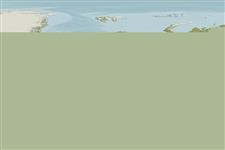Classification / Names
Common names | Synonyms | Catalog of Fishes(genus, species) | ITIS | CoL | WoRMS | Cloffa
Teleostei (teleosts) >
Ophidiiformes (Cusk eels) >
Ophidiidae (Cusk-eels) > Ophidiinae
Etymology: Ophidion: Diminutive of Greek, ophis = serpent (Ref. 45335); saldanhai: Named in honor of the Portuguese ichthyologist Luis Saldanha (Ref. 34017).
Eponymy: Professor Dr Luiz Viera Calds Saldanha (1937–1997) was aprominent Portuguese ichthyologist. [...] (Ref. 128868), visit book page.
Environment: milieu / climate zone / depth range / distribution range
Ecology
Marine; demersal; depth range 31 - 37 m (Ref. 34017). Tropical
Eastern Central Atlantic: known only from Cape Verde and the Gulf of Guinea.
Size / Weight / Age
Maturity: Lm ? range ? - ? cm
Max length : 15.0 cm SL male/unsexed; (Ref. 34017)
Short description
Identification keys | Morphology | Morphometrics
Dorsal spines (total): 0; Dorsal soft rays (total): 117; Anal spines: 0; Anal soft rays: 105 - 106. Color of fresh holotype: Pale pink, with a silver to golden stripe all along middle body, and a more silvery area a the preopercular region, behind and under the eye. The dorsal portion of the head (snout and nape) and of the body was slightly darker. Belly pigmentation whitish. The margins of the dorsal and anal fins were edged in white; blackish subterminal stripe, darker at the rear of the fins. Black pupil and iris reddish to silvery, with a black blotch at the dorsal portion (Ref. 34017).
Reproductive strategy possibly similar to other members of this family featuring oviparity, with oval pelagic eggs floating in a gelatinous mass (Ref. 205).
Life cycle and mating behavior
Maturity | Reproduction | Spawning | Eggs | Fecundity | Larvae
Matallanas, J. and A. Brito, 1999. Description of Ophidion saldanhai sp. nov. from the Cabo Verde Islands. J. Fish Biol. 55(5):931-936. (Ref. 34017)
IUCN Red List Status (Ref. 130435: Version 2024-2)
Threat to humans
Harmless
Human uses
Fisheries: bycatch
Tools
Special reports
Download XML
Internet sources
Estimates based on models
Preferred temperature (Ref.
123201): 16.6 - 27, mean 19.5 °C (based on 25 cells).
Phylogenetic diversity index (Ref.
82804): PD
50 = 0.5000 [Uniqueness, from 0.5 = low to 2.0 = high].
Bayesian length-weight: a=0.00102 (0.00046 - 0.00225), b=3.06 (2.88 - 3.24), in cm total length, based on all LWR estimates for this body shape (Ref.
93245).
Trophic level (Ref.
69278): 3.5 ±0.7 se; based on size and trophs of closest relatives
Resilience (Ref.
120179): High, minimum population doubling time less than 15 months (Preliminary K or Fecundity.).
Fishing Vulnerability (Ref.
59153): Low vulnerability (10 of 100).
